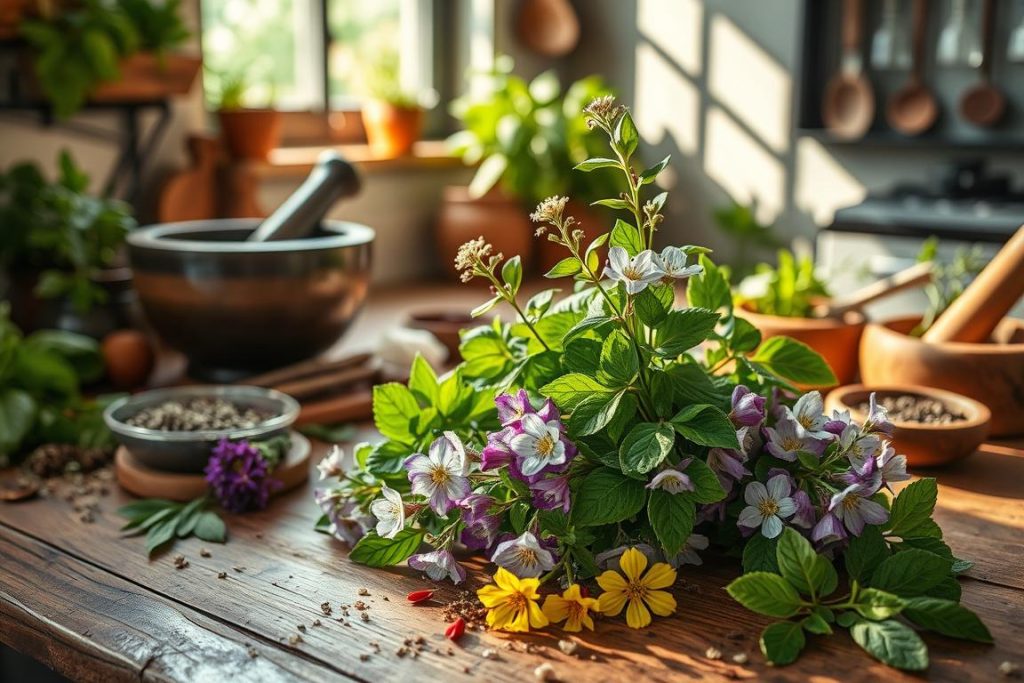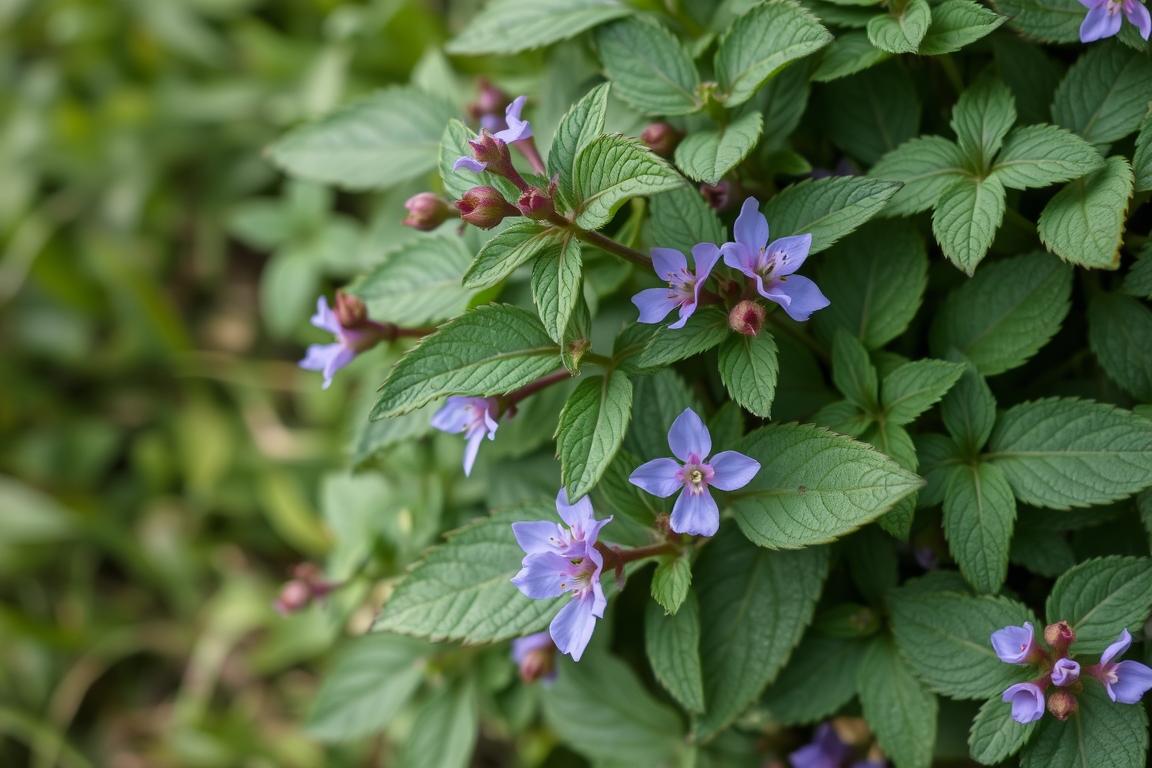Mugwort (Artemisia vulgaris) is a fascinating plant used in traditional medicine for ages. It helps with digestion, menstrual issues, and stress. Let’s dive into mugwort’s history, what it’s made of, and its health benefits.
Artemisia vulgaris, or mugwort, is in the daisy family. It grows in the northern hemisphere. It likes different climates and is good for food and medicine. Its taste is like mint and juniper, loved in Northern Europe.
Mugwort has been used in medicine for a long time. But, the FDA doesn’t watch over supplements like it does medicines. This means we need to be careful when picking mugwort products. Also, mugwort is related to ragweed, which can cause allergies in some people.
Despite these things, mugwort’s benefits are still interesting to many. Studies show it might help with irritable bowel syndrome with diarrhea (IBS-D). This shows mugwort’s value in traditional medicine.
What Is Mugwort: Understanding the Ancient Herb
Mugwort, or Artemisia vulgaris, is a plant that grows all year. It has green leaves with white hair underneath and purple stems. Its smell is like rosemary and sage, and it has bright flowers.
Botanical Classification and Plant Description
Mugwort belongs to the Artemisia family, with over 200 types. It can grow up to six feet tall. It can live in many places, from cold to hot.
Geographic Distribution and Growing Conditions
Mugwort grows all over the world, especially in Europe and Asia. It loves rich soil and can grow in many places. It’s found in fields, by roads, and in disturbed areas.
Historical Significance Across Cultures
Mugwort has been important for a long time. Its name comes from the Greek goddess Artemis. It’s used in women’s health and in traditional Chinese medicine.
In shamanistic cultures, it helps talk to ancestors. In medieval Europe, it kept evil spirits away. It also keeps moths away when burned.
The Rich History of Mugwort in Traditional Medicine
Mugwort has a long history in traditional medicine. It was used in ancient Greek and Roman times. People believed it helped with menstrual and pregnancy issues.
In the Middle Ages, Europeans called it „mater herbarum“ or „mother of herbs.“ They used it for protection and many health issues.
In Traditional Chinese Medicine (TCM), mugwort helps with stomach and women’s health. It’s also used in moxibustion. This is when they burn the herb near acupuncture points to help the body heal.
„Mugwort has been considered one of the nine sacred herbs to Anglo-Saxon tribes, reflecting its deep-rooted significance in traditional healing practices.“
Today, mugwort is used in new ways. People use it to improve dreams and explore its ancient uses.
Mugwort is a hardy plant found in the Northern Hemisphere. It’s still interesting to many today. Its long history and uses make it worth studying and exploring.
Chemical Composition and Active Compounds
Mugwort, also known as Artemisia vulgaris, is full of good stuff. It has essential oils, flavonoids, and more. These help it work well for health.
Essential Oils and Aromatic Components
The essential oil from mugwort leaves in Brazil has 18 parts. The big ones are oxygenated sesquiterpenes, sesquiterpene hydrocarbons, and oxygenated monoterpenes. The main parts are caryophyllene, germacrene D, and humulene.
These parts help fight off bad bacteria and fungi. They work well against Staphylococcus aureus and Candida albicans.
Beneficial Plant Compounds
Mugwort also has flavonoids, coumarins, and more. These help fight off bad stuff and protect us. Artemisinin is one special part that might help fight cancer and malaria.
Nutritional Profile
Mugwort is also good for you because it’s full of vitamins and minerals. It has vitamins A, C, and K, and minerals like iron and calcium. All these help keep you healthy.
Modern Research on Mugwort’s Health Benefits
Modern studies and clinical trials on mugwort are still growing. But, what we know so far is exciting. It seems this ancient herb could help with many health issues.
Some studies say mugwort might help with digestion. It could make bile production better. This could make your stomach work better.
Also, mugwort might soothe itchy skin on scars. This is because of a lotion made with mugwort and menthol.
Mugwort might also protect against diseases caused by too much stress. It could help lower blood pressure and improve blood flow. This is based on traditional use.
Research shows mugwort might help with women’s health issues. It could help with irregular periods. Mugwort might even fight off bacteria and fungi.
„Mugwort is a versatile herb with a long history of traditional use, and modern research is beginning to uncover its diverse health benefits.“ – Dr. Sarah Adams, Herbalist
But, we need more research to know everything about mugwort’s benefits. Always talk to a doctor before using mugwort for health.
Digestive Health Support and Applications
Mugwort is an ancient herb known for its digestive health benefits. It helps improve bile production, which is key for digestion.
Improving Bile Production
Mugwort relaxes the gut and bile ducts, boosting bile production. Bile breaks down fats, proteins, and nutrients. This makes digestion more efficient.
Gastrointestinal Benefits
Mugwort’s bitter taste and smell help make digestive juices. It might help with irritable bowel syndrome with diarrhea. But, more research is needed.
Mugwort could be a natural aid for gastrointestinal health and bile production. Always talk to a doctor before using it for digestive aid.
Menstrual Health and Women’s Wellness
Mugwort is a special herb known for its health benefits for women. It helps with menstrual cycles and eases menstrual pain.
For a long time, mugwort has helped with irregular and painful periods. Its special oils and compounds might help balance the female body.
But, mugwort is not safe for pregnant women. It can cause uterine contractions and increase miscarriage risk. Pregnant women should talk to doctors before using mugwort.
Even though mugwort is known for its benefits, more research is needed. Some studies suggest it might help with menstrual issues, but more studies are needed.
Using mugwort should be done carefully. Always talk to a doctor, especially if you have health issues. Making smart choices is key when using traditional remedies.
„Mugwort has been revered for centuries as a natural ally in supporting women’s health and wellness, particularly in the realm of menstrual regulation and pain management. However, its use during pregnancy requires utmost care and consideration.“
Antioxidant Properties and Immune Support
Mugwort is a special herb from the Artemisia family. It’s known for its antioxidants. These are good for our bodies.
It has things like flavonoids and phenolic compounds. These help protect our cells from harm.
Free Radical Protection
Mugwort’s antioxidants fight free radicals. Free radicals are bad for our cells. They can cause sickness.
Eating mugwort might help keep us healthy. It could lower the chance of getting sick.
Cellular Defense Mechanisms
- Studies show mugwort can make our cells stronger. It does this by making antioxidant enzymes work better.
- These enzymes help our bodies fight off bad stuff. They keep us healthy.
- Mugwort also helps our immune system. It keeps us from getting sick as easily.
More research is needed to know how good mugwort is. But, it might help keep us healthy. Adding mugwort to our diet could be good for us.
„Mugwort’s antioxidant compounds have been shown to scavenge and neutralize free radicals, preventing them from causing harm to your cells.“
Traditional Uses in Chinese Medicine
In Traditional Chinese Medicine (TCM), mugwort is very important. It’s also known as Artemisia vulgaris. TCM uses mugwort in moxibustion to help heal and improve health.
Moxibustion burns dried mugwort leaves near acupuncture points. This helps move „Qi,“ or life energy, in the body. It supports digestion, helps with menstrual issues, and boosts overall health.
Moxibustion therapy in Chinese medicine aims to strengthen blood and energy flow. It keeps health good. Indirect moxibustion is safe and common, where moxa doesn’t touch the skin.
Health practitioners say moxibustion boosts energy flow through the body. This happens through pathways called meridians.
| Condition | Moxibustion Research Findings |
|---|---|
| Chronic Kidney Disease | One study found that moxibustion therapy is effective for chronic kidney disease, reducing serum creatinine levels significantly. |
| Menopausal Hot Flashes | Research involving 51 women in postmenopausal stages concluded that undergoing 14 sessions of moxibustion helped reduce the severity and frequency of hot flashes. |
| Ulcerative Colitis | Scientific evidence regarding the use of moxibustion for ulcerative colitis is inconclusive, with studies suggesting it may not provide benefits, albeit of low quality. |
| Breech Birth | Moxibustion is considered a safe alternative to help with breech birth, although a 2005 study did not establish its effectiveness conclusively. Moxibustion can significantly reduce the need for medical procedures aimed at correcting breech birth presentation. |
The effectiveness of moxibustion and Traditional Chinese Medicine needs more study. But, they are still interesting and worth researching. It’s best to have moxibustion done by experts for the best results and safety.
Different Forms and Preparations of Mugwort
Mugwort is a versatile herb. It can be used in many ways to help your health. You can drink it as tea, use essential oils, or take supplements.
Teas and Infusions
Mugwort tea is a popular choice. It’s made by steeping dried leaves in hot water. This tea is soothing and smells nice.
Start with 1 teaspoon of dried herb for every 8 ounces of water. You can drink it hot or cold. It might help with digestion and menstrual issues.
Essential Oils and Extracts
Mugwort essential oil is used in aromatherapy. It’s made from the leaves and flowers. The oil has compounds that might help you feel better.
Mugwort extracts, like tinctures, are strong. They can be taken by mouth or used on the skin. They have the plant’s active parts in a concentrated form.
| Mugwort Preparation | Potential Benefits | Precautions |
|---|---|---|
| Teas and Infusions | Digestive support, menstrual regulation | Avoid during pregnancy |
| Essential Oils | Aromatherapy, topical applications | Use with caution, potential skin irritation |
| Herbal Supplements | Concentrated active compounds | Consult a healthcare provider for proper dosage |
Be careful with mugwort, especially essential oils and supplements. Always talk to a doctor first. They can help you use it safely and right.

Safety Considerations and Potential Risks
Mugwort is usually safe for most people. But, it’s good to know about possible side effects and when not to use it. People allergic to ragweed, celery, birch, or carrots should be careful. They might get skin problems, asthma, or even a serious reaction called anaphylactic shock.
Pregnant women should avoid using mugwort, as it may increase the risk of miscarriage. Also, people with diabetes should talk to their doctor before using mugwort. It can change blood sugar levels.
Mugwort has a compound called thujone. Too much of it can be harmful. Using mugwort essential oils can be risky. It might hurt your liver, kidneys, and heart.
- Mugwort is related to the Artemisia plant family and can cause cross-reactivity with other members, such as sage and wormwood.
- Studies have shown IgE cross-reactivity between mugwort pollen, birch pollen, and certain foods like celery, carrots, and spices, leading to the „celery-mugwort-birch-spice syndrome.“
- Mugwort has also been linked to cross-reactivity with hazelnut, pine nut, and mango, potentially causing allergic reactions in sensitive individuals.
Always talk to a healthcare provider before using mugwort. This is especially true if you have health issues or take medicines. Following the right dosage and use can help avoid risks and ensure safety.
„Mugwort is a powerful herb, but it’s important to use it with caution and under the guidance of a healthcare professional.“
Proper Dosage and Administration Guidelines
Using mugwort right is key. There’s no set dose because of little research. But, there are safe ways to use it.
For mugwort supplements, follow the label. Start with a small dose and watch for side effects. Talking to a doctor or herbalist can help find the right amount for you.
How you use mugwort changes with its form. Drink mugwort tea or use essential oils in different ways. Always use it as directed for safety.
Even though mugwort is natural, it’s not safe for everyone. Start with small amounts and watch how your body reacts. Getting advice from health experts is crucial for using mugwort safely.
| Mugwort Administration Method | Dosage Recommendations | Safety Considerations |
|---|---|---|
| Teas and Infusions | Start with 1-2 cups per day, adjusting as needed | Avoid during pregnancy and breastfeeding |
| Essential Oils | Use 2-3 drops per application, dilute in a carrier oil | Avoid direct skin application, conduct a patch test |
| Supplements | Follow product label instructions | Consult a healthcare provider before use |
For safe mugwort use, start with small doses. Watch your body and get advice from a health expert.
Mugwort in Culinary Applications
Mugwort, also known as Artemisia vulgaris, is a special herb in cooking. It’s a plant that grows back every year. It’s known for its smell and many uses in food.
Traditional Recipes
Mugwort has flavored many foods over time. It tastes like the earth and grass. It’s used in soups, stews, and even teas.
The young parts of the plant are good in salads. The flowers add a special taste to dishes.
Modern Culinary Uses
Now, chefs are using mugwort in new ways. Places like Coin de Rue Bakery in Los Angeles make mugwort lattes and mugwort mochi. They mix its taste with coffee and mochi.
Mugwort is great for seasoning many foods. Its leaves add depth to soups and stews. It’s like sage but different.
Coastal mugwort is also used in cooking. It’s from the Pacific Northwest. The Chumash Nation has used it for food and medicine for a long time.
You can make mugwort honey or vinegar. It’s good in chutneys and tarts. Its taste makes any dish better.

„Mugwort adds an earthy and grassy flavor to dishes, complementing the rich flavors of coffee and offering a blend of tradition and innovation in the café experience.“
Growing and Harvesting Mugwort
Mugwort is a tough and flexible herb. But, it grows fast and can spread too much. Before you plant it, check local laws. In places like Maine, New York, and Indiana, it’s banned.
Mugwort likes many soils and can grow in zones 3-8. This makes it good for many gardens. But, it can take over and harm native plants.
The best time to pick mugwort is just before it blooms. This way, you get the most oil and smell. Use the leaves and stems for cooking and medicine. Don’t let it spread by picking the flowers.
Mugwort is useful but needs care. It has strong chemicals that can be bad if eaten too much. Pregnant women should avoid it. Grow it in pots or special areas to keep it from taking over.
Knowing mugwort’s good and bad points helps gardeners and herbalists. With the right care, it can be a great addition to your herb garden or natural medicine cabinet.
Interactions with Medications and Contraindications
Mugwort has been used for centuries in traditional medicine. But, it’s important to be careful when mixing it with some medicines. Mugwort can interact with many drugs, which can be risky for people taking prescription or over-the-counter medicines.
Mugwort can make blood flow more, which might increase the chance of bleeding. This is especially true for people taking medicines like warfarin, clopidogrel, or NSAIDs like ibuprofen or aspirin. Also, mugwort might change blood sugar levels for people with diabetes.
| Medication | Potential Interaction |
|---|---|
| Anticoagulants (warfarin) | Increased risk of bleeding |
| Anti-platelet drugs (clopidogrel) | Increased risk of bleeding |
| NSAIDs (ibuprofen, aspirin) | Increased risk of bleeding |
| Diabetes medications | Potential impact on blood glucose levels |
Before using mugwort, talk to a healthcare provider or pharmacist. This is especially important if you have health issues or take medicines, including herbal supplements. It’s key to use mugwort safely and avoid drug interactions and medication safety issues.
„The safe use of herbal supplements requires open communication with healthcare providers to prevent potential drug interactions and ensure medication safety.“
Conclusion
Mugwort has a long history in herbal medicine. It might help with digestion, menstrual issues, and as an antioxidant. But, we need more research to know for sure.
It’s usually safe but can cause allergies and interact with some medicines. Always start with a small amount and talk to a doctor. This is especially true if you have health problems or take medicines.
Mugwort has special compounds like flavonoids and terpenes. These might help with health in many ways. Some people say it helps with menstrual problems and discomfort. But, we need more studies to be sure.
Mugwort’s history and uses are interesting. If you use it, do it carefully and talk to a doctor. This way, you can try mugwort safely in your health routine.



